
JohanB
-
Posts
142 -
Joined
-
Last visited
Content Type
Profiles
Forums
Downloads
Posts posted by JohanB
-
-
Read the document I linked to in post 12, this one:
http://www.crossy.co.uk/Handy%20Files/groundwire.pdf
It's in Thai but the diagrams are quite clear.
I´m very surprised you (they) recommend grounding to neutral connection AND grounding rod in the wiring diagrams.
I thougt the standard installation recommended in Thailand is T-T with no connection between incoming neutral and the ground rod.
Otherwise why do you need a grounding rod?
I usally have around 11 VAC on the neutral and that will corrode and eat upp my grounding rod in a short time.
Also adding to my electric bill...
There is another more serious reason too:
Most houses in Thailand are connected to the mains through over-head 1 phase power lines.
My first built small house is situated around 150 meters from the meter pole and there are 6 concrete poles carrying 2x 16mm2 copper wires to the house.
When we arrived one time a couple of years ago, and I were doing some measuring for extending the installation, I noticed that the neutral and live were altered in the house.
The reason was very horrifying but understandable...
It was a tree that had fallen down and cut my power lines to the house. Our house keeper had it fixed by some local electrican.
But he had switched the wires so the neutral was carrying mains voltage....!!
If I had "grounded" my shower and AC etc in the incomming neutral it would have been a death trap!!
Even if there were a 2 meter ground rod installed, it can not short-circuit the mains live current.
The earth around the rod, the wire or connection to the ground rod will fry and leave live voltage to all "earted" installations.
Also a correctly installed RCB (ECLB)would not be of any help as there is no fuse in that connection.
The ground rod can not be connected after the RCB as the residual current between neutral and ground will trip it very quick.
Johan
-
Just one tip that we used to recommend.
Don't use the ELCB on the fridge circuit.
Separately wire one circuit, just for the fridge and EARTH it.
the reason being is that you go away for a week-end or a week's holiday and the neighbour (who has secretly tapped into your supply or a friend who fe3eds your cat etc has tripped the ELCB and now your Sirloin Steak bought for 800 baht a kilo is now a shade of green and not fit for the neighbours dog (who you dislike).
You occasionally get some nuisance tripping when a Washing Machine is involved ... or should I say ... used to.
A very good recommendation.
I've done the same in my installations (2 houses).
Freezer and fridge connected before the RCB (Residual Current Breaker)
A heafty thunder storm will many times tripp the RCB, especially if you have garden lights with digged down long wires connected to it.
-
-
OK No hard feelings, I have not taken part of your earlier research,
but I've a house very close to the Mae Wong River downstreams, so I'm a
little worried.
Can you please give a link to the earlier thread and confirm, that we
are talking of the same fault line on around N15deg 55min,
E99deg19min
Johan
Had a look, and I may have been referring to the wrong fault line, and a different dam. I previously looked at the Mae Yom (different dam) and the Mae Wong Dam seems to be on the Moei fault.
That said, while there have been a couple of shakes recorded, the last movement on the Moei fault is listed as Late Quaternary, around 2.5 million years back. Link provided.
http://www.dmr.go.th/ewtadmin/ewt/dmr_web/main.php?filename=fault_En
I can see in the documents, that the Moei fault has a slip rate of 0.36mm/year.
The "Late Quaternary" move was probably of an other magnitude.
http://www.docstoc.com/docs/2815790/South-East-Asia-Seismic-Hazard-Maps
This fault line on the proposed MaeWong dam builing site is clearly seen on Google Earth satellite photos. See on the cordinates above.
Johan
-
Ther is really a great risk of disaster if the Mae Wong Dam is to be built.
Because there is a significant active fault line is passing under the building site.
I have not seen this mentioned anywhere in the debate...
Anyone are free to use this data to bring it to higher level, to stop this crazy project.
Link to the Thai offical geological maps:
http://www.dmr.go.th/ewtadmin/ewt/dmr_web/main.php?filename=Download_geo_En
The map to look for is ND47-3.pdf (Nakhon Sawan)
The Mae Wong River is seen in the upper left part of the geological map and the fault line is very clear!!
And if you stop accepting BS as fact and look into it a little further, you will find that there is no evidence of movement in this "active fault" for thousands of years, nor is any expected for thousands more.
300 million tons of water and an earthquake in Burma maybe change that. Who gives a 1000+ years guarantee?
Who asks for one? I took the trouble in an earlier thread to do some research on the fault line, and found it is only "active" on a geological time scale far in excess of the expected life of the dam. Raising the spectre of disaster is common greeny pseudo-science aimed at the ill-informed and gullible.
OK No hard feelings, I have not taken part of your earlier research, but I've a house very close to the Mae Wong River downstreams, so I'm a little worried.
Can you please give a link to the earlier thread and confirm, that we are talking of the same fault line on around N15deg 55min, E99deg19min
Johan
-
Ther is really a great risk of disaster if the Mae Wong Dam is to be built.
Because there is a significant active fault line is passing under the building site.
I have not seen this mentioned anywhere in the debate...
Anyone are free to use this data to bring it to higher level, to stop this crazy project.
Link to the Thai offical geological maps:
http://www.dmr.go.th/ewtadmin/ewt/dmr_web/main.php?filename=Download_geo_En
The map to look for is ND47-3.pdf (Nakhon Sawan)
The Mae Wong River is seen in the upper left part of the geological map and the fault line is very clear!!
And if you stop accepting BS as fact and look into it a little further, you will find that there is no evidence of movement in this "active fault" for thousands of years, nor is any expected for thousands more.
300 million tons of water and an earthquake in Burma maybe change that. Who gives a 1000+ years guarantee?
-
Ther is really a great risk of disaster if the Mae Wong Dam is to be built.
Because there is a significant active fault line is passing under the building site.
I have not seen this mentioned anywhere in the debate...
Anyone are free to use this data to bring it to higher level, to stop this crazy project.
Link to the Thai offical geological maps:
http://www.dmr.go.th/ewtadmin/ewt/dmr_web/main.php?filename=Download_geo_En
The map to look for is ND47-3.pdf (Nakhon Sawan)
The Mae Wong River is seen in the upper left part of the geological map and the fault line is very clear!!
-
How to make a steady "raft slab" in pictures. The red stuff spreaded on the yellow sand is "Lacterite", but good "MacAdam" will do too if you can find.
attachment=149746:Maelaewa 283.jpg]
/Johan
Like I said thats a beaut of a build, thanks for the great pictures, interesting for some who want to go the same way.

There's usually a land location reason for raft type foundations, was this in your case or was it your preference.?
I would also think it is not in the buget for some who want to build and out of there price range.
The 8 square shuttered poles with reinforcement within would be considered as columns which are raised from the slab and being tied in as you say.

Congratulations and enjoy your new home it looks great.
Yes, some parts of the ground under the house is quite soft and watery and other parts dry and solid. Thats the reson I wanted the stiff slab to float on the land.
Its actually 2 slabs, forming a T with a lose connection to release tension. Movement between them is only a couple of millimeters in 3 years.
The reason I wanted to build exactly there in this spot, is the nice and clean Mae Wong River, passing by below the veranda......
/Johan
-
-
I built our house ,by my own drawings, in a remote area in Nakhon Sawan, a couple of years ago of 20cm superblocks (AAC) on a reinforced concrete raft slab without poles. Prefabricated (by uur selves) steel trusses bolted to cast in lugs on a 5x15cm reinforced concrete lintel around the perimeter of the walls.
All electric and water pipes are cut in to the superblocks. You can cut 25mm in to a 20cm superblock, without risk the structual strength. Th only concrete poles you see in some pics, are only cast into the beams and not digged out under. They are for supporting the roof over the almost open mid-section-room in the house.
The problem I encountered was that nobody had any knowledge of using AAC:s in a load bearing construction on a concrete raft slab. I think the pole-system, even in non/wooden houses, is a heritage from building with wooden poles.
The company Superblock even sent instructors with the shipment, to teach our builing crew. (village workers)
Very nice too, looks a great build, maybe the way for " bigdod " to go.
Yes maybe a good idea, but you must know how to make the slab sitting steady on the soil. To have a stable slab is the key to a good building that never cracks.
First shave away all organic material from the building site. Then level the site with a very stiff material called "Lacterite" (used in road construction) Or Macadam, hire in a road compactor to compact the foundation firmly.
Then used gravel and sand under the slab reinforcement beams, with absolutely no organic material in it.
Compacted sand, ground-cloth ( also used in road construction), and washed gravel top layer in the filling between the beams under the slab, to cut the mostiure suck up path from the ground.
All layers watered compacted separately, so the whole underside of the slab is supported.
This makes the load on the ground distributed all under the slab and the ground pressure very low / SQ-meter. The slab is actually "floating" on the ground, so thats why its called "Raft slab"
I will put some more pictures in a separate post, not to risk loosing my writing on the slow EDGE internet I have.
/JohanB
-
I built our house ,by my own drawings, in a remote area in Nakhon Sawan, a couple of years ago of 20cm superblocks (AAC) on a reinforced concrete raft slab without poles. Prefabricated (by uur selves) steel trusses bolted to cast in lugs on a 5x15cm reinforced concrete lintel around the perimeter of the walls.
All electric and water pipes are cut in to the superblocks. You can cut 25mm in to a 20cm superblock, without risk the structual strength. Th only concrete poles you see in some pics, are only cast into the beams and not digged out under. They are for supporting the roof over the almost open mid-section-room in the house.
The problem I encountered was that nobody had any knowledge of using AAC:s in a load bearing construction on a concrete raft slab. I think the pole-system, even in non/wooden houses, is a heritage from building with wooden poles.
The company Superblock even sent instructors with the shipment, to teach our builing crew. (village workers)
-
A recourcefull link that explains it all about construction in Australia:
-
Thanks Crossy for the suggestions.
This was a graet tip on that point out the HDPE tube. Is that High Density PE or what stands the HD for?
Also a great idea of sealing with PU-foam and silicon on top of that.
It is quite dry land at an altitude of 300m leaning terrain, so we are at no risk of flooding at all. Only seasonal heavy rains soaks the ground as everywhere here.
All wiring will also be inside our land, so nobody else is going to suffer for a bad installation.
What danger or disadvatage can you see in using the 16mm2 THW-cable in this application? This is the common cable also used for overhead wiring in this remote countryside area of Mae Wong?
/Johan
-
Hi,
I am going to dig down an 1 phase incomming 220V mains cable from a 15/45A meter. The last 50 meter will go underground between a ordinary cement pole and the house.
I already have 2 spools x100meter of THW 16mm2 copper 750V copper wires from BCC and will run them through some sort of sleeve under ground.
Anyone have experience of what type of sleeving to use when digging down the cables.
I have to chose from the yellow PVC tubing, with glued or unglued joints, or one continous length of the black 25mm PE (Polyethylene tubing commonly used for underground water suplies).
My thoughts about this are:
1) I am a littled worried about having standing water in the tubes for ever or maybe it does not matter...
2) With unglued joints, the water, that always will leak in, also has a chance to seap out....
3) With the PE tube sleeving I can seal the open ends with silicon and protect them from direct water (raining or submerging) and hope no water will be there for ever.....
4) Glued joints yellow PVC piping with silicon sealed ends and hope no water will be there for ever...........
Does any experienced member here around have some serious conciderations about this??
/JohanB
-
Epilogue and last "official statement" from the Swedish tabloid Expressen.
Unaltered translation by Google:
"Swedish couple died in the shower - no need to clarify
AO NANG. In here, killed two young Swedes, when the shower was energized. But no criminal investigation will not be launched, said police sources for Expressen. The equipment in the shower of death has already been dismantled and the evidence is destroyed. - It is common that hotels pay the police to avoid criminal investigations, says while a Swedish lived several years in the country.
On the hotel grounds Mild Bungalows, on the outskirts of the resort of Ao Nang in Krabi Province, Thailand, would no longer talk about the tragedy on Saturday.
When Expressen yesterday visited the hotel staff first tried to joke away the event.
- That's nothing to write about. Do not want to rent a room instead? asked a hotel employee at the reception.
Trims shrubs and smiles
Outside the bungalow A2, where the Swedes from a village in Jämtland lived, ongoing horticultural activities as if nothing had happened. A man cut the bushes around the house and smiles.
Just hours after the accident on Saturday left a large number of Scandinavians hotel.
The couple - a 25-year-old man and a 23-year-old woman - died almost immediately when they stood in the live shower. Their Swedish friends, who both in the bungalow next door, heard a scream. Then there was silence.
The couple lay dead in the shower when his friends rushed in - and the water on the floor was still live.
Confiscated equipment
According to hotel staff were the local police on the ground less than 20 minutes after the accident, and it was quickly decided that the equipment in the current bungalow would be demolished and confiscated.
A Swedish lived in Thailand for several years testifies to Expressen that it often happens that people die of live showers. It is only when the tourists hit by the attention of the media abroad.
- In Thailand, are almost always the electric water heater is mounted inside the shower-cabin. Only major hotels are centrally heated water, the source said.
No requirements
He asserts that hotels rarely use grounded power supply and that there is no requirement that technicians install water heaters for example, in the showers.
- Normally, you see the earth wire that is mounted externally on the water heater.
The same source reports that hotels are insured against crime investigation in each month to pay for local police officers.
- In all probability, have called their police when this happened because he must have
charge of the investigation, and the fault lies with all certainty in how the equipment was installed, not the equipment itself. So the evidence is now cleared away by the police, "said the Swede.
Pure accident
When Expressen, yesterday visited the police office in Ao Nang said the officer of the watch the event on the hotel grounds Mild Bungalows was a pure accident.
- There has been no criminal investigation. It was an accident.
As tourists were involved, he refers to his then boss, Big Boss, the police office in Krabi, but nobody wanted to go in response to questions.
"Enough with the questions now"
Express searched yesterday hotel owner, a Chinese businessman, on several occasions. The staff at Mild Bungalows stated first that he was on a business meeting in Krabi. But when asked if he was willing to answer questions by phone, the answer was:
- It's unfair that he gets the blame for what has happened. Therefore he does not want to talk. Suffice it matters now.
The hotel owner has been in the media denied that the shower would become energized. He also requested that the bodies of the young Swedes will remain in the country until the investigation is completed.
By Niklas Svensson
April 6, 2011 at 06:54 "
-
I realize the increased dangers of a wet human coming into contact with a voltage differential over that of a dry human as this is the reason for the whole topic about electrical dangers in the shower. Water definitely increases the risk of electrocution in an unsafe environment but generally by direct contact with a primary conductor and not the water alone.
I don't know if the following is the right way to calculate the conductivity of water and thus how dangerous it would be in a given situation. What I came up with seems to say the same as in BB's post above. I would like to hear from people who might be at odds with these numbers. Set me straight if I am in error here. I used the standard current=voltage devided by resistance, same as you would for a more conventional conductor.
I took some Ohm readings for water and water based solutions. Weather it was tap water, or a 'shower water', (water, salt, and hand soap), that I was measuring, (in higher concentration than I would expect to find under shower conditions), the resistance figures point to a current flow in the liquid well below danger level, when applied to either 120v or 240v.
Here are my test figures. Tested: two inches of liquid in a glass bowl, test probes less than one inch apart for all readings. All figures have been rounded up.
Tap water resistance was 308 k ohms = current of .0004A (at 120v) .0008A (at 240v)
Shower Water (water, salt, soap) resistance was 125 k ohms = current of .001A (at 120v) .002A (at 240v)
Yes you're in error here. The area of the test probes in the water must be in accordance with the area equal of of a hand or a foot print. some 100 to 300 cm2.
JohanB
-
Something I always do is to practice what electricians refer to as the 'one hand in your pocket rule'. In the shower, what this means is that you never use two hands at the same time, in regards to touching and operating anything in the shower. Something as simple as turning hot and cold water knobs at the same time, one in each hand, can complete an electrical circuit and cause you to be electrocuted. Of course, this is only in places where an electrical problem exsists. Using both hands to wash your body is not a problem. If a person has an understanding of how electrical circuits work, then they usually have a good idea of how to be safe in such situations. The main thing is to prevent two points of your body from possibly completing an electric circuit, especially one that would provide a path through your heart. Learning about how electrical circuits work is good knowledge to have and easy to come by in books or online. Books are better in my opinion. I don't want you to be over worried about the possibility of being electrocuted in a hotel shower. I have been traveling for many years and following the simple precautions mentioned above in the multitude of different hotel rooms I have showered in, I've never had a problem.
I'm sorry to tell you, that what you're saying above is completly wrong, when it comes to showers!! You have mixed up two things!!
The "one hand in the pocket" trick is used by electricians and also by radio & TV repairmen at the times when the voltages was very high, not to touch or catch the metal of the repair object with the other hand even if it was falling over on the workbench. The electrician-repairman is absolutely not grounded, but always well isolated from ground by a rubber shoes/mat or by other means.
In a faulty shower the deadly current could easily pass through your heart from one hand to your feet on the wet floor.
That's what happend to both the swedes in this thread.
The man had severe burns on his feet, which proves that the wet floor was conducting as the earth path.
You never had a problem in your hotel rooms, but who says the swedish couple had any problems before they died. When they had problems, they were already electrocuted!!
The only solution to home & hotel owners is to GROUND the electric water heaters to a ground rod or similar with a 2,5sq-mm green kopper wire, that could bear the current to blow the fuse.
A Residual Current Device RCD should of course be used in the central to get extra protection. But as they are mecanical devices they are not 100% reliable.
If the water heater has an ELCD built in, make sure it don't needs a ground connection to work properly.
Please read the wikipedia link by MaiChai a few posts earlier. There are evidently ELCD:s that need a ground connection, according to that information!!
The RCD:s don't use or need a ground connection.
/JohanB, Electronic Engineer, Sweden
-
Swedish tabloid Expressen reports today that the Thai police is not going to make a criminal investigation!!
It will be considered as an "accident!!
Police have also dismantled all equipments from the bathroom in the resort Mild Bungalows, bungalow A2, including the waterheater and hoses and deliberatly destroyed all evidence!!
see further at: expressen.se Svenskt par dog i dusch - utreds inte (Swedish couple died in a shower - not investigated)
Reading that these victims suffered burns made me think there was the possibility the metal parts that carried the electricity in this event, might also have carried marks from the electricity that could be used to figure out how the event happened. Not always the case that the electricity leaves a 'trail' of clues, but when higher power is involved it can.
The initial police report says she had several long burns on the upper torso and was intangled in the shower hose on the floor.
I assume these burns was probably from the metal shower hose. The man had severe burns on his feet.
The report says the girl screamed first in the shower and then the man rushed in and tried to resque her, but was also trapped and electrocuted, probably by grabbing her on the wet floor.
As the evidences are destroyed by police, we don't know when the deadly voltage started, but it could have been when a thermostat or presure sensitive heater switched on the heater coil during the shower. The heter tank was evidently not grounded.
/JohanB
-
Swedish tabloid Expressen reports today that the Thai police is not going to make a criminal investigation!!
It will be considered as an "accident!!
Police have also dismantled all equipments from the bathroom in the resort Mild Bungalows, bungalow A2, including the waterheater and hoses and deliberatly destroyed all evidence!!
see further at: expressen.se Svenskt par dog i dusch - utreds inte (Swedish couple died in a shower - not investigated)
-
There was, according to the news, an electric heated hot water tank below the roof, serving 2 bathrooms in the bungalow.
The standard thai-style in-wall plumbing for hot water, is by galvanized steel pipes down to the metal faucets also built into the wall, that we can se in the pictures.
What we also can see in one photo is a a glimpse of a metal shower hose.
If there was a conduct from the electric wiring into the heater tank, that metal spun hose will accordingly carry leathal voltages and current through the steel tubes!!
The wet tile floor with widespread rebars or metal mesh in the always wet concrete, is a perfect ground return path for the current.
The outlets are normally of plastic in Thailand and are probably not involved here.
This scenario also complies with the reported burns injuries.
So, if the hot water tank was properly grounded, this tragic accident would never have happend!! Only a blown fuse or some burned wires....
/JohanB, electronic engineer, Sweden
-
Hi,
The hotel in Ao Nang was Mild Bungalows.
It is pubished in the swedish newspaper Expressen now.
Expressen.se
/JohanB



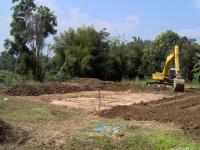


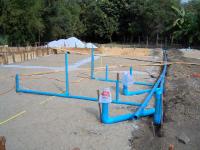
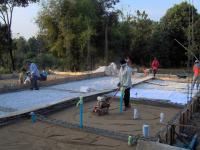
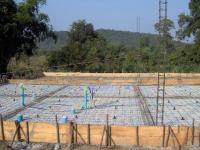


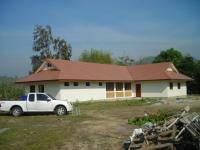

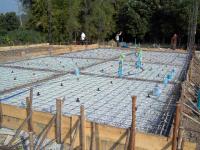

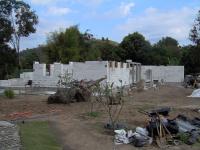
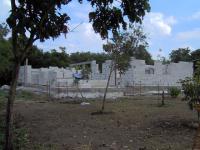


Mae Wong report scrapped
in Thailand News
Posted · Edited by JohanB
My god, this small stream (not river) is threatening the existance of whole country and exterminate the thai people.....